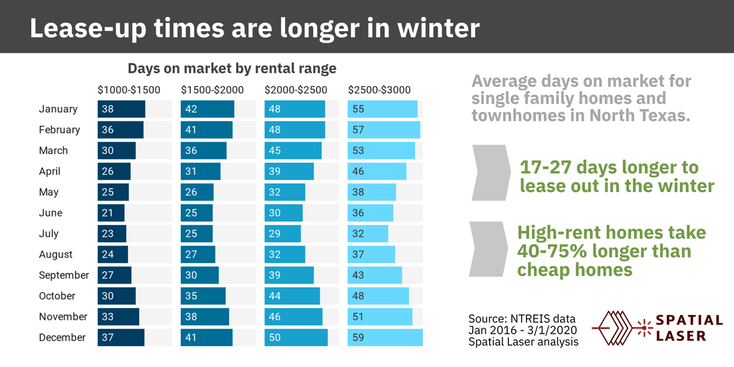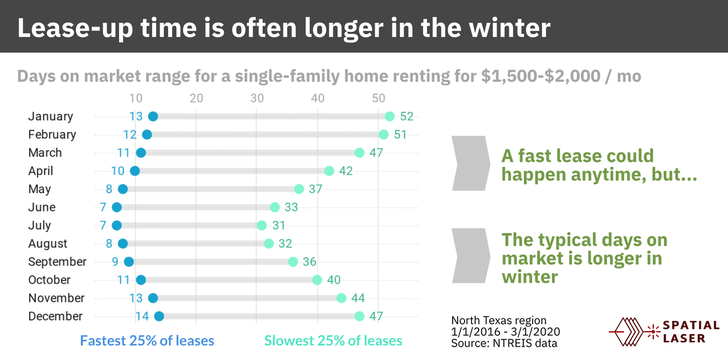For a real estate investor trying to fill a vacancy, it is not uncommon to find big differences between summer and winter. Summer vacancies get snapped up quickly by renters, and the reasons are quite simple:
- Many people try to move during summer school vacation to minimize disruptions for their school-age children.
- Job-related relocations tend to happen well outside of the “holiday season” of November and December. The result is more demand for rentals in the summer months.
How much longer does a lease take in winter?
We crunched nearly 140,000 lease records from the North Texas region from the start of 2016 through to the eve of the Covid pandemic in March 2020, to see how much of a seasonal difference exists in our market. (We did not analyze the abnormal period during the pandemic, which is a separate discussion.)
Seasons do matter. For all price categories, it took, on average, two to four weeks longer (17-27 days longer) to rent out a house in winter than in summer.
For all rental levels, it took, on average, two to four weeks longer (17-27 days) to rent out a house in winter than in summer.
We also found that, on average, cheaper homes rented out faster. The pool of demand for cheaper homes is larger, as there are more potential renters. Meanwhile, high-rent homes take longer to rent out. We calculated that it takes 10-20 days longer to secure a tenant for a $2500-$3000/mo home compared to a $1000-$1,500/mo home.
We calculated that it takes 10-20 days longer to rent out a $2500-$3000/mo home compared to a $1000-$1,500/mo home.
Is a fast lease still possible in the winter?
The short answer is yes, if priced right.
The averages tell one part of the story, but there are still wide ranges for what can actually happen. Below, we show what the range looks like between the fastest 25% of the leases, with the fewest days on market, and the slowest 25%, with the most days on market.
Fast lease ups do happen in the winter, though they aren’t as common. The fastest 25% of leases in winter took less than two weeks, for homes listed in a rental range of $1,500-$2,000/mo.
What you can do
An extended vacancy period has a big effect on the profitability of a real estate investment. For a house renting for $1,750 a month, each day of vacancy costs you $60. A long vacancy period of 40 to 60 days results in a 10-15% drop in revenue for the year.
The best way to combat this situation is to time leases to expire during the summer, when your days on market are likely to be lowest.
If a winter vacancy is unavoidable, your second-best option is to price the rent slightly lower than you might in the summer, in order to minimize the days on market. Most of the time, a small discount in rent is worth it, if it cuts your vacancy period to a minimum.


